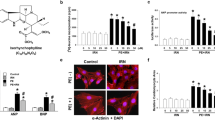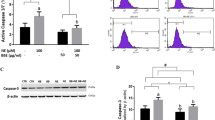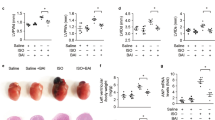Abstract
The myocardial protective effects of trilinolein, isolated from the traditional Chinese herbSanchi (Panax notoginseng), are thought to be related to its antioxidant activity. However, the intracellular mechanism underlying the protective effect of trilinolein in the heart remains unclear. In the present study, we investigated the effect of trilinolein on norepinephrine (NE)-induced protein synthesis in cardiomyocytes. Cultured neonatal rat cardiomyocytes were stimulated with NE, then protein content, [3H]-leucine incorporation, and β-myosin heavy chain (β-MyHC) promoter activity were examined. The effect of trilinolein on NE-induced intracellular reactive oxygen species (ROS) generation was measured with a redoxsensitive fluorescent dye (2′,7′-dichlorofluorescin diacetate) and extracellular signal-regulated kinase (ERK) phosphorylation by Western blotting. Trilinolein inhibited NE-increased protein synthesis, β-MyHC promoter activity, and intracellular ROS. Both trilinolein and the antioxidant, N-acetyl-cysteine, decreased NE- and H2O2-induced protein synthesis, β-MyHC promoter activity, and ERK phosphorylation. These data indicate that trilinolein inhibits NE-induced protein synthesis via attenuation of ROS generation in cardiomyocytes.
Similar content being viewed by others
References
Adams JW, Brown JH. G-proteins in growth and apoptosis: Lesions from the heart. Oncogene 20:1626–1634;2001.
Bueno OF, Molkent JD. Involvement of extracellular signal-regulated kinases 1/2 in cardiac hypertrophy and cell death. Circ Res 91:776–781;2002.
Chakraborti S, Chakraborti T. Oxidant-mediated activation of mitogen-activated protein kinases and nuclear transcription factors in the cardiovascular system: A brief overview. Cell Signal 10:678–683;1998.
Chan P, Cheng JT, Tsao CW, Niu CS, Hong CY. The in vitro antioxidant activity of trilinolein and other lipid-related natural substances as measured by enhanced chemiluminescence. Life Sci 59:2067–2073;1996.
Chan P, Niu CS, Cheng JT, Tsao CW, Tsai SK, Hong CY. Trilinolein preserves mitochondria ultrastructure in isolated rat heart subjected to global ischemia through antioxidant activity as measured by chemiluminescence. Pharmacology 52:216–225;1996.
Chan P, Niu CS, Tomlinson B, Hong CT, Chen JP, Hong CY, Tsai SK, Cheng JT. Effect of trilinolein on superoxide dismutase activity and left ventricular pressure in isolated rat hearts subjected to hypoxia and normoxic perfusion. Pharmacology 55:252–258;1997.
Chan P, Thomas GN, Tomlinson B. Protective effects of trilinolein extracted fromPanax notoginseng against cardiovascular disease. Acta Pharmacol Sin 23:1157–1162;2002.
Cheng TH, Shih NL, Chen SY, Loh SH, Cheng PY, Tsai CS, Liu SH, Wang DL, Chen JJ. Reactive oxygen species mediate cyclic strain-induced endothelin-1 gene expression via Ras/Raf/extracellular signal-regulated kinase pathway in endothelial cells. J Mol Cell Cardiol 33:1805–1814;2001.
Cheng TH, Shih NL, Chen SY, Wang DL, Chen JJ. Reactive oxygen species modulate endothelin-I-induced c-fos gene expression in cardiomyocytes. Cardiovasc Res 41:654–662;1999.
Clerk A, Pham FH, Fuller SJ, Sahai E, Aktories K, Marais R, Marshall C, Sugden PH. Regulation of mitogen-activated protein kinases in cardiac myocytes through small G proteinRac1. Mol Cell Biol 21:1173–1184;2001.
Frey N, Olson EN. Cardiac hypertrophy: The good, the bad, and the ugly. Annu Rev Physiol 65:45–79;2003.
Hasegawa K, Lee SJ, Jobe SM, Markham BE, Kitsis RN. cis-Acting sequences that mediate induction of beta-myosin heavy chain gene expression during left ventricular hypertrophy due to aortic constriction. Circulation 96:3943–3953;1997.
Hirotani S, Otsu K, Nishida K, Higuchi Y, Morita T, Nakayama H, Yamaguchi O, Mano T, Matsumura Y, Ueno H, Tada M, Hori M. Involvement of nuclear factor kappa B and apoptosis signal-regulating kinase 1 in G-protein-coupled receptor agonist-induced cardiomyocyte hypertrophy. Circulation 105:509–515;2002.
Hong CY, Lai LJ, Shiao MS, Chiang BN. Effect of triacylglycerols on erythrocyte deformability in vitro. Prostaglandins Leukot Essent Fatty Acids 48:351–353;1993.
Karin M. The regulation of AP-1 activity by mitogen-activated protein kinases. J Biol Chem 270:16483–16486;1995.
Liang C, Rounds NK, Dong E, Stevens SY, Shite J, Qni F. Alterations by norepinephrine of cardiac sympathetic nerve terminal function and myocardial beta-adrenergic receptor sensitivity in the ferret: normalization by antioxidant vitamins. Circulation 103:96–103;2000.
Luo JD, Xie F, Zhang WW, Ma XD, Guan JX, Chen X. Simvastatin inhibits noradrenaline-induced hypertrophy of culture neonatal rat cardiomyocytes. Br J Pharmacol 132:159–164;2001.
Minamino T, Yujiri T, Terada N, Taffet GE, Michael LH, Johnson GL, Schneider MD. MEKK1 is essential for cardiac hypertrophy and dysfunction induced by Gq. Proc Natl Acad Sci USA 99:3866–3871;2002.
Obata T, Yamanaka Y. Cardiac microdialysis of salicylic acid to detect hydroxyl radical generation on nonenzymatc oxidation by norepinephrine in rat heart. Biochem Pharmacol 53:1375–1378;1997.
Obata T, Yamanaka Y. Cardiac microdialysis of salicylic acid to detect hydroxyl radical generation associated with sympathetic nerve stimulation. Neurosci Lett 211:216–218;1996.
Oin F, Rounds NK, Mao W, Kawai K, Liang CS. Antioxidant vitamins prevent cardiomyocyte apoptosis produced by norepinephrine infusion in ferrets. Cardiovasc Res 51:736–748;2001.
Petrashevskaya NN, Koch SE, Bodi I, Schwartz A. Calcium cycling, historic overview and perspectives. Role for autonomic nervous system regulation. J Mol Cell Cardiol 34:885–896;2002.
Schaub MC, Hefti MA, Harder BA, Eppenberger HM. Various hypertrophic stimuli induce distinct phenotypes in cardiomyocytes. J Mol Med 75:801–920;1997.
Shih NL, Cheng TH, Loh SH, Cheng PY, Wang DL, Chen YS, Liu SH, Liew CC, Chen JJ. Reactive oxygen species modulate angiotensin II-induced beta-myosin heavy chain gene expression via Ras/Raf/extracellular signal-regulated kinase pathway in neonatal rat cardiomyocytes. Biochem Biophys Res Commun 283:143–148;2001.
Sugden PH. Signaling pathways in cardiac myocyte hypertrophy. Ann Med 33:611–622;2001.
Tanaka K, Honda M, Takabatake T. Redox regulation of MAPK pathways and cardiac hypertrophy in adult rat cardiac myocyte. J Am Coll Cardiol 37:676–685;2001.
Thompson WR, Nadal-Ginard B, Mahdavi V. A MyoD1-independent muscle-specific enhancer controls the expression of the beta-myosin heavy chain gene in skeletal and cardiac muscle cells. J Biol Chem 266:78–88;1991.
Wang DL, Chen KK, Shih NL, Kao YC, Hsu KH, Huang WY, Liew CC. Endothelin stimulates cardiac alpha- and beta-myosin heavy chain gene expression. Biochem Biophys Res Commun 183:1260–1265;1992.
Xiao L, Pimentel DR, Wang J, Singh K, Colucci WS, Sawyer DB. Role of reactive oxygen species and NAD(P)H oxidase in apha(1)-adrenoceptor signaling in adult rat cardiac myocytes. Am J Physiol Cell Physiol 282:C926-C934;2002.
Yue TL, Gu JL, Wang C, Reith AD, Lee JC, Mirabile RC, Kreutz R, Wang Y, Maleeff B, Parsons AA, Ohlstein EH. Extracellular signal-regulated kinase plays an essential role in hypertrophic agonists, endothelin-1 and phenylephrine-induced cardiomyocyte hypertrophy. J Biol Chem 275:37895–37901;2001.
Author information
Authors and Affiliations
Rights and permissions
About this article
Cite this article
Liu, JC., Chan, P., Chen, JJ. et al. The inhibitory effect of trilinolein on norepinephrine-induced β-myosin heavy chain promoter activity, reactive oxygen species generation, and extracellular signal-regulated kinase phosphorylation in neonatal rat cardiomyocytes. J Biomed Sci 11, 11–18 (2004). https://doi.org/10.1007/BF02256544
Received:
Accepted:
Issue Date:
DOI: https://doi.org/10.1007/BF02256544




